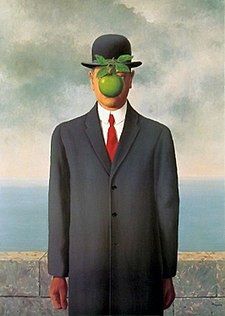The Son of Man
From Wikipedia, the free encyclopedia
 |
| The Son of Man |
| René Magritte, 1964 |
| Oil on canvas |
| 116 cm × 89 cm (45.67 in × 35 in) |
The Son of Man (French: Le fils de l'homme) is a 1964 painting by the Belgian surrealist painter René Magritte.
Magritte painted it as a self-portrait. The painting consists of a man in a suit and a bowler hat standing in front of a small wall, beyond which is the sea and a cloudy sky. The man's face is largely obscured by a hovering green apple. However, the man's left eye can be seen peeking over the edge of the apple. Another subtle feature is that the man's left arm appears to bend backwards at the elbow.
About the painting Magritte said,
- At least it hides the face partly. Well, so you have the apparent face, the apple, hiding the visible but hidden, the face of the person. It's something that happens constantly. Everything we see hides another thing, we always want to see what is hidden by what we see. There is an interest in that which is hidden and which the visible does not show us. This interest can take the form of a quite intense feeling, a sort of conflict, one might say, between the visible that is hidden and the visible that is present.[1]
The Son of Man should not be confused with The Great War on Facades (La Grande Guerre Façades), another Magritte painting featuring similar imagery. Both feature a person standing in front of a wall overlooking the sea. The Great War on Facades, however, features a woman holding an umbrella, her face covered by a flower. The painting should also not be confused with Man in the Bowler Hat, a similar painting where the man's face is obscured by a bird rather than an apple.
The Son of Man is privately owned.
[edit] References
- ^ In a radio interview with Jean Neyens (1965), cited in Torczyner, Magritte: Ideas and Images, trans. Richard Millen (New York: Harry N. Abrams), p.172.
|
|||||||||||

